Ad Austrum
Ad Austrum is a luxury rental in the south of France full of charm, surrounded by fruit trees and vineyards. It is located 15 min from Uzès close to all the sights of Languedoc-Roussillon.
The château is hugged by two hills like in a cocoon, but with generous, wide-open views.
What is the story behind Château de Sibra, what was your inspiration to create it?
I have friends who live in the region and I have been visiting for years. It feels like the end of the world. But with the views of the Pyrenees and the wind from either the Mediterranean or the Atlantic, you also feel connected to the world. It’s a region that’s touristic enough but not overrun.
So I started looking around for a property to buy but didn’t find anything, until a call from an acquaintance about a place that was about to go on sale. The day I first saw it the weather was horrible. But as we were strolling through the park, I completely fell in love. I did my master’s thesis on Romantic landscape parks, so it really touched me. I had a harder time with the main building but the location was so amazing that I decided to take on the adventure.
We began by restoring the outbuildings as they weren’t liveable, then in the second phase, we moved on to the château. I am an architect by trade, so I oversaw the restoration and the interior design, with a lot of great people working on the project. I bought the château in 2017 and submitted the building permit in 2018, ready for work to start that summer. It took three years to complete and we opened in the summer of 2021.
How would you describe the atmosphere and interior design of Château de Sibra?
The chateau is a weird building as it is designed in a mixture of different historic styles — it’s a collage. For my generation of architects who are trained in a modern style, it’s extremely difficult and it took me a little while to realise what Villary de Fajac (who had redone the chateau in the 1880s) was trying to achieve.
But once I looked at the building as he intended, as a series of stories to be told, it became quite loveable and fun. Through the restoration, I hope we were able to reawaken and retell some of these stories.
It’s not like some châteaus with these huge spaces that you get lost in. It’s generous in size but also warm and cosy.
While the ground floor was lived in (with a very 1950s French style), the second floor hadn’t been used in a long time and was largely untouched (except for a new roof). Because it was in its original state, we had the old wallpapers and flooring to work with. We were able to reprint many of the wallpapers using the original paper and pigments and we had a team in Morocco who redid some of the tiles. In the places where we couldn’t recreate the original features, we interpreted them as closely as possible using the same colours.
In terms of the interior design, I wanted to put pieces of furniture in the rooms that stood in the space. But if you removed them, it wouldn’t destroy the existing room. I love contemporary furniture and have been collecting it all my life, so designing the interiors of the chateau was a good opportunity to declutter my home in Switzerland.
For Villary de Fajac, the Château de Sibra was a living experiment — he was developing a concept around living. So I really didn’t want to create a museum but rather honour this living experiment and protect it.
To you personally, what is so special about Château de Sibra?
The Château de Sibra is hugged by two small hills but with these grand views. So it is like you are in this cocoon, but a generous, wide-open one. It’s something that our guests notice also and many don’t want to leave!
It’s also special for me because I spent so much time researching and trying to understand the project of the Villary de Fajacs. It’s like they have become good friends and the project they started is something that I have taken on. They had this vision of creating an Arcadian world, which is again appealing to many people today. To devote your life to that experiment is something I find extremely fascinating and to propel it a little bit into our time is a fun challenge.
On the ground floor of the château, you enter the lobby where there’s a terrazzo floor showing the royal lily of France, which was quite a bold statement to make in 1880. There is also a wonderful tapestry here that suggests while science may allow us to explore the world and all of its natural phenomenon, there is always a reality that it cannot touch.
If you turn left, you enter the main salon with a great fireplace, a grand piano and contemporary furnishings. If you turn right, you’ll find the breakfast room, which is completely covered in hand-painted textiles depicting Sibra’s park and the Villary de Fajacs hunting. Then you come to a small space (a former gentleman’s room) where you can play chess or games and a medieval library with hand-painted textiles and a beautiful wooden fireplace.
In the northern part of the chateau there is a large kitchen, which used to be the main kitchen and which we completely redid. We use it for preparing breakfast and open it up to guests if they come back from the local markets and want to prepare meals.
The grand staircase that connects to the second floor is framed by reprinted granite-style wallpaper (something that was very fashionable at the time). It leads into a private salon, which is one of the few rooms we reworked, taking out some of the walls during the restoration. On the second floor are four guest rooms and there is a fifth on the mezzanine floor with views across the garden and the castle courtyard.
Located on the mezzanine floor, the Suite du Fils consists of the “blue salon”, a bedroom with an exceptional turquoise tiled stove and high ceiling, plus a spacious dressing room and bathroom. It enjoys a view onto the flower and vegetable garden to the west and to the castle’s spacious court to the east.
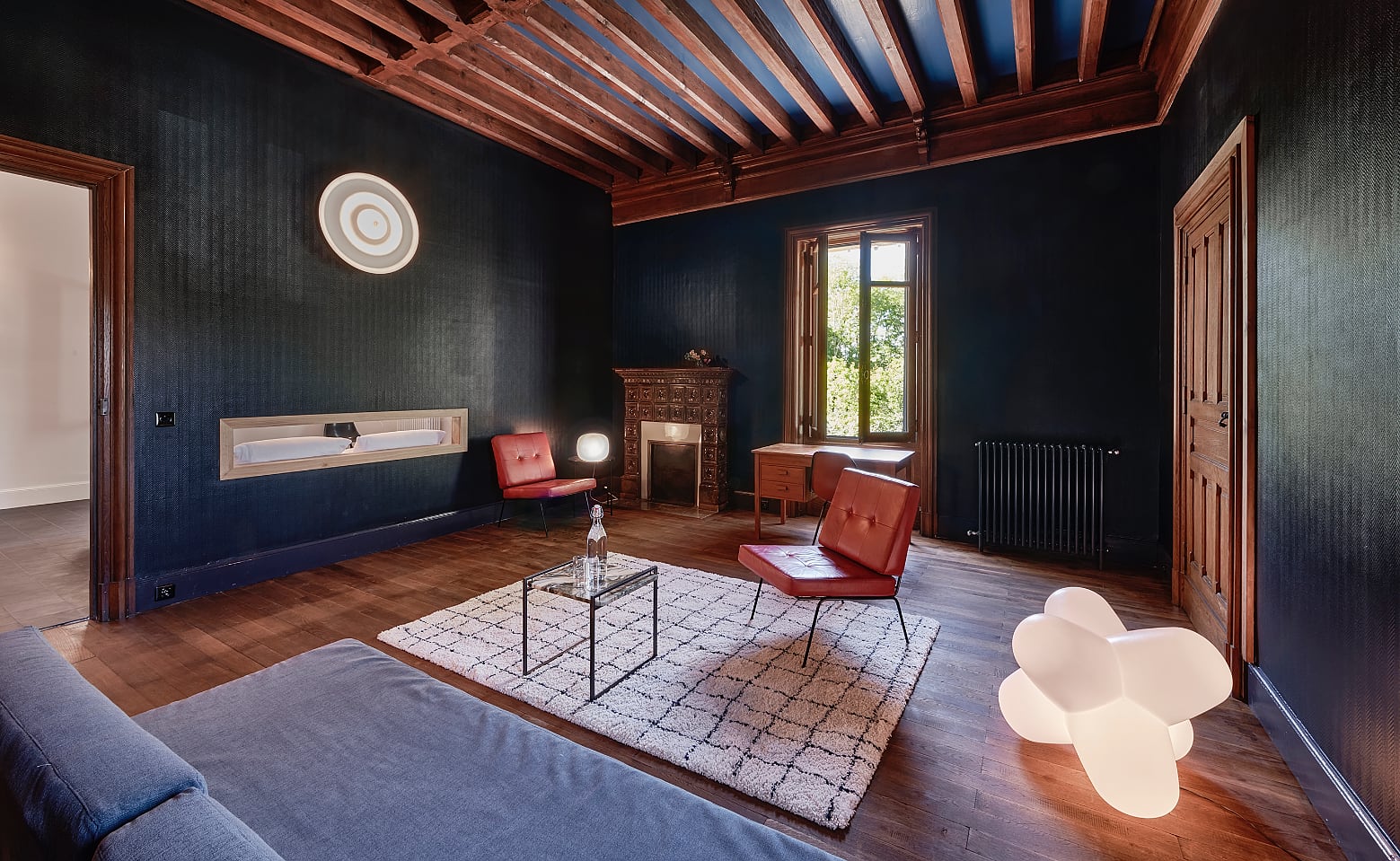
The magnificent view from the two windows onto the park and the 6-metre-high bathroom are the eye-catchers of this large room with its two walk-in closets and a working area.
The green-grey embossed wallpaper gives the elegant room a light and airy feel. The high ceiling decorated with the original stucco-work, and a white fireplace with a gilded mirror are further highlights. Restored, upholstered chairs, once having belonged to Madame, invite you to relax and unwind.
The bright bathroom, surprisingly decorated with little pink windows, is the crowning glory: a 6-metre-high canopy ceiling vaults above the bathtub, held in place by 4 stone heads.
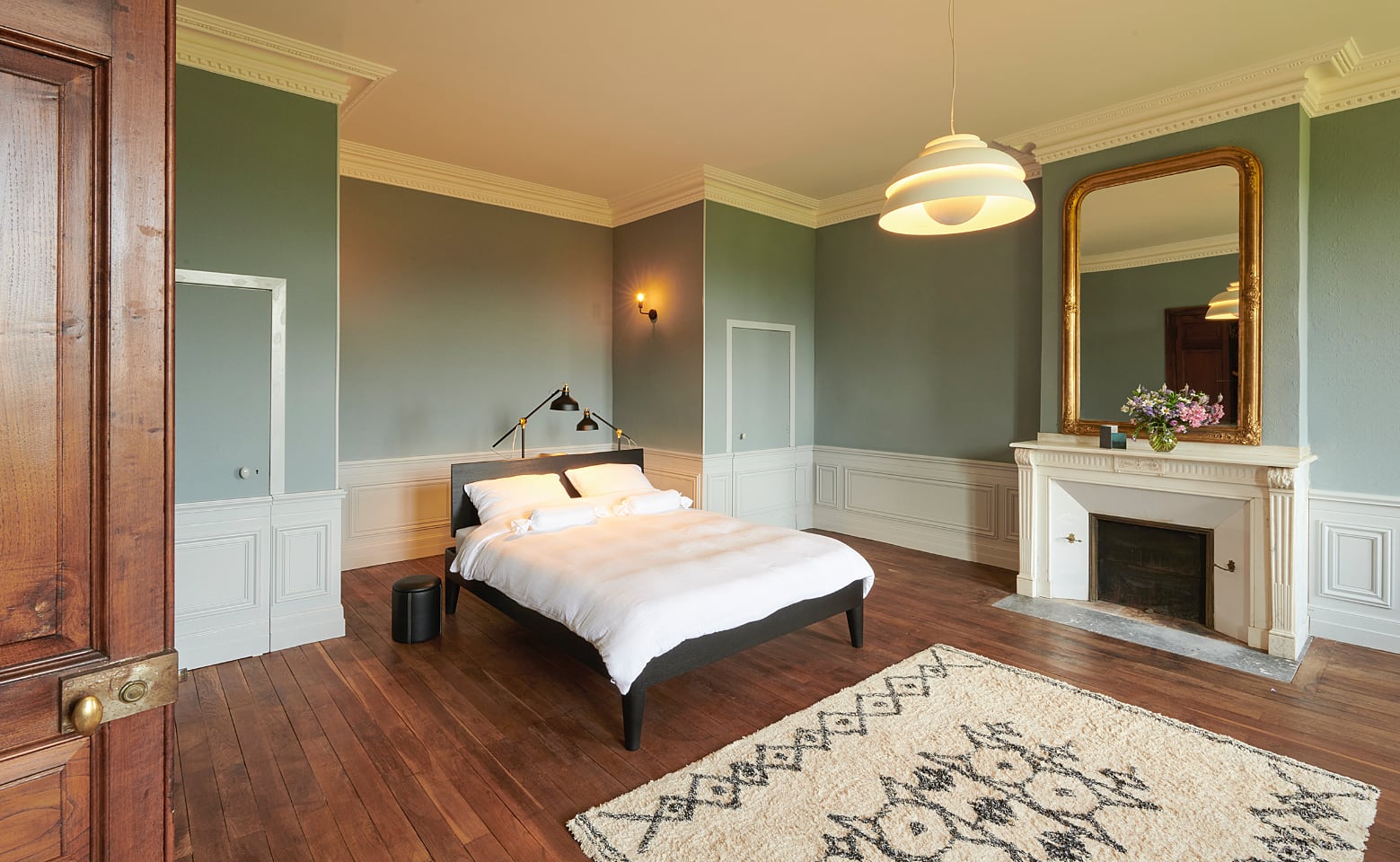
Vis à Vis of Madame lived Monsieur. Here, too, the view onto the park plays the main role. The light grey embossed wallpaper and the woodwork emphasize the room's beautiful proportions. A sitting area and a comfortable reading chair provide a modern contrast to the marble fireplace decorated with shells and topped with a golden mirror.
In the spacious bathroom, lined with Art Nouveau tiles, a bathtub on lion's feet invites you to take a relaxing bath. The bathroom also has its own window overlooking the park.
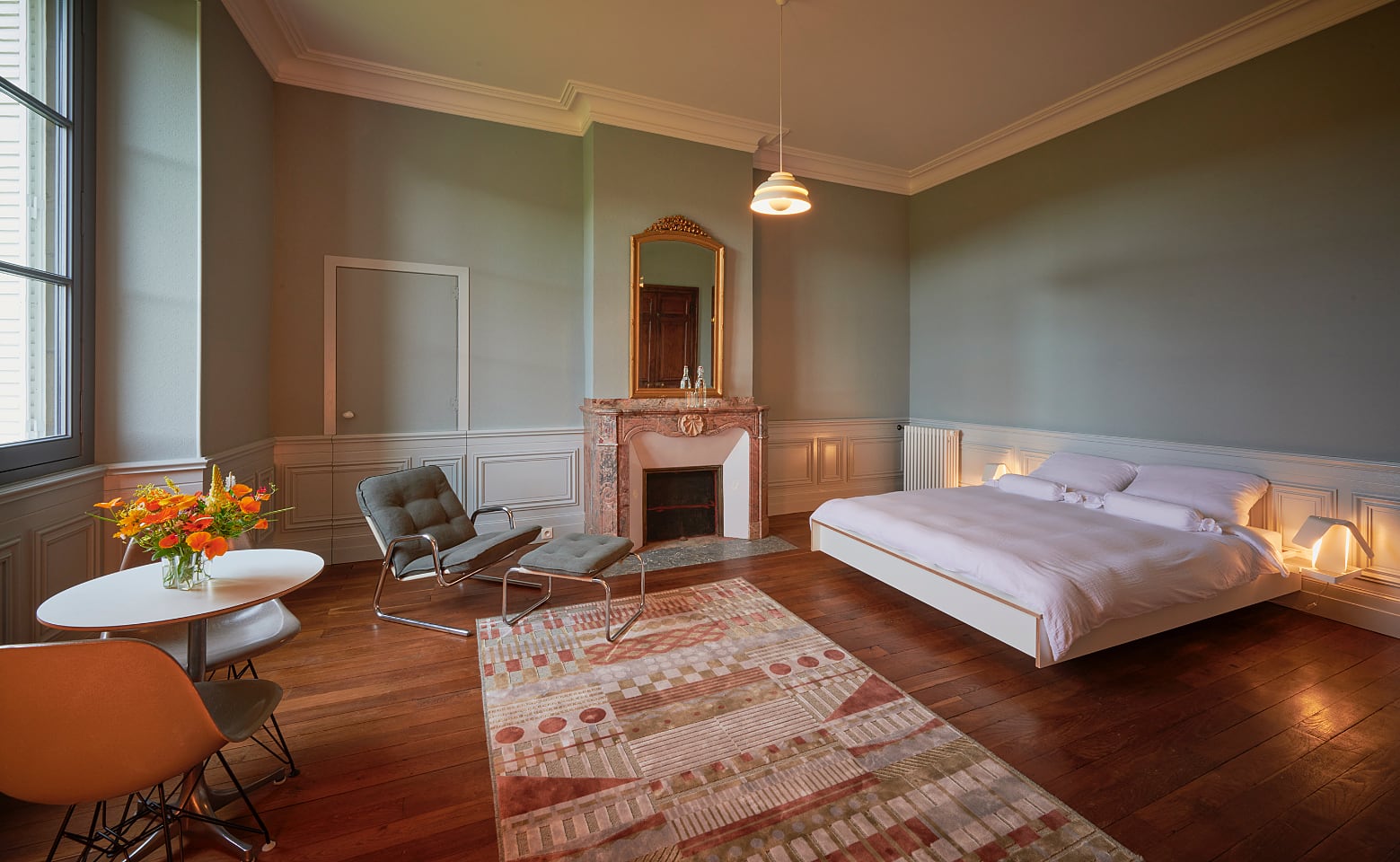
A glass door leads to the south-west room, the salle d'armes. A huge double window offers a painting-like view of the park. Opposite the bed, the majestic red marble fireplace and its antique mirror adorn this room. In contrast, comfortable contemporary armchairs in bright colors enhance the tone and invite you to relax.
In this suite, the wardrobe is housed in a separate tower boudoir. The spectacular circular bathroom with stained glass windows is located at the end of a corridor tiled with original floral tiles.
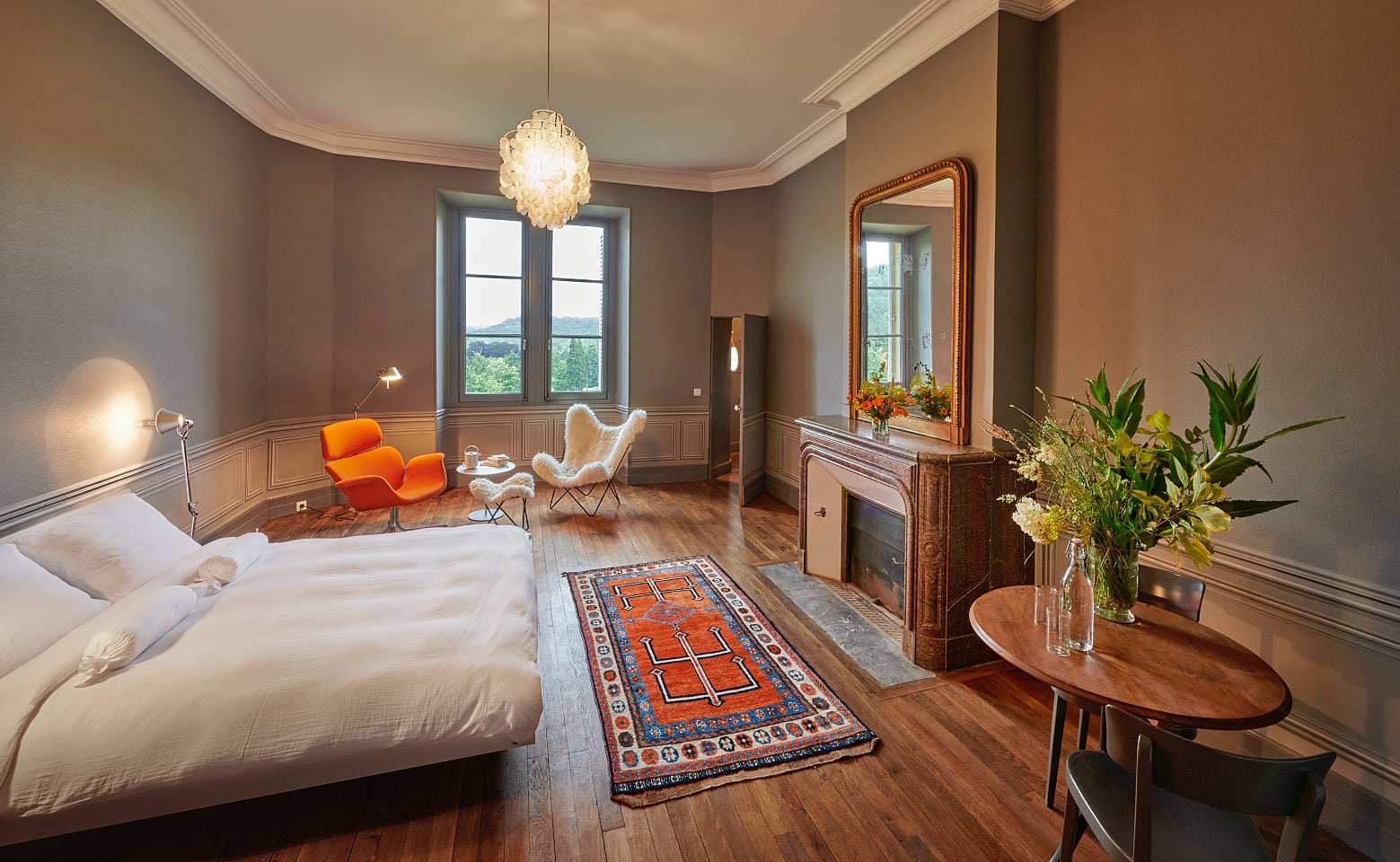
The main attraction of this cosy room is a noble wooden cabinet wall, which directs the view out to the romantic flower garden.
The large room is decorated with a wallpaper carefully reproduced form the original whose white and blue motif dates back to the 18th century. It makes this room uniquely fresh. A lamp by George Nelson floats in the room like a zeppelin. The contemporary furniture provides a playful contrast to the old wooden wardrobe and floorboards. The wardrobe doors conceal a separate WC, a shower room and two walk-in closets.
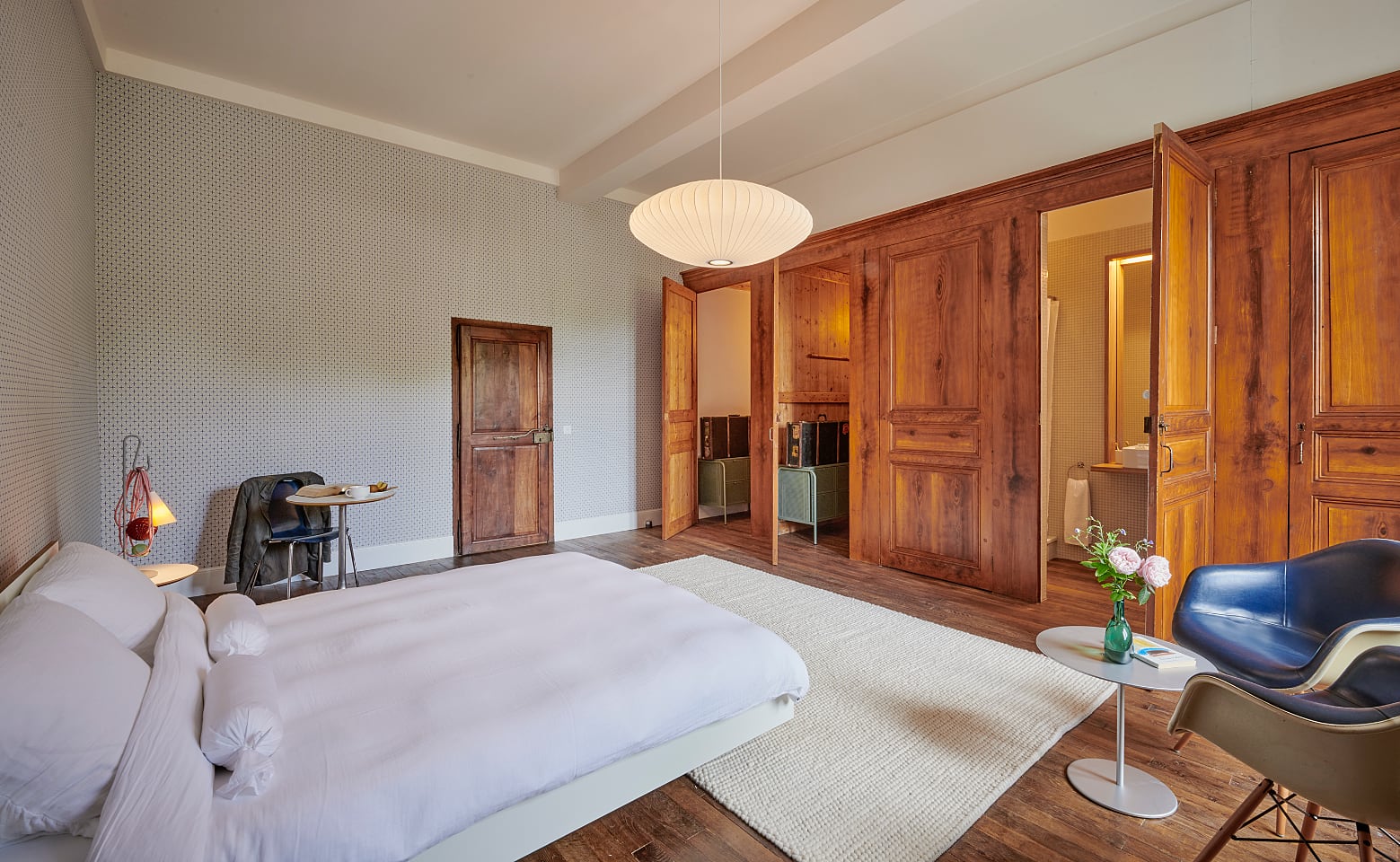
In the chateau, we serve breakfast each morning on the terrace and dinners are available on request. A few times a week, we also do cold platters with meats, cheeses and small salads, accompanied by regional wines. There is a kitchen that is available to guests if they want to self-cater in the evenings and we set up a long table in the park in the summertime. We also have bicycles available for rent and cleaning is provided every day.
Children are welcome to explore and play in the park accompanied by their parents.
Please note that a swimming pool will be ready by May/June 2022.
Within 30 minutes’ drive of the Château de Sibra, there is a great collection of cultural activities, including the centuries-old Cathar castles. The closest one is the Chateau de Montsegur, which is around 20 minutes’ drive, plus a 40-minute hike. You need good shoes! They built their castles on the top of very steep mountains but with fantastic views.
Carcassonne is also quite lovely but can get very busy with tourists in the summer months. Nearby is a wonderful little chapel that has been carved into the stone (in fact, it’s around four churches built on top of one another) and features beautiful frescoes. There are also prehistoric wall paintings nearby, one of the few in France that are still accessible, although you do need to make a reservation.
I also love following the old railroads that have been transformed into cycling routes. You ride beneath tunnels and bridges that look surprisingly similar to the walls of the Chateau de Sibra. A short drive south is the Lac de Montbel where you can bathe, go sailing or rowing.
The Château de Sibra is located in the southwest of France in the middle of the Pays Cathare, a region that has been heavily influenced by this 11th and 12th-century religious sect. We are eight kilometres from Mirepoix, a medieval town with supermarkets, bookstores and boutiques, which also hosts a produce market twice a week.
UNESCO-listed Carcassonne is 15 minutes away and surrounded by completely intact walls. The “Pink City” of Toulouse (France’s fourth largest city) is an hour from the property and home to the Airbus headquarters. The closest restaurant is around five kilometres away in an old monastery or there are lots of great restaurants in Mirepoix.
I love the beautiful landscapes — you are in the foothills of the Pyrenees with lots of wonderful hikes, little lakes and rivers, as well as different species of wild orchids. There is great wine in the region and it is steeped in history. With the exception of Carcasonne, it’s not completely overrun with tourists, so you have the opportunity to see these treasures privately. It makes for a tourist experience that is quite personal and I find intensely moving.
Register
Your contact details will allow you to message or book a property in the guest area. Sunshine awaits!
Already registered? Log in
Log in